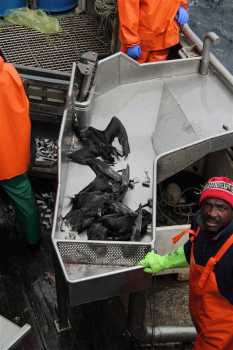
White-chinned Petrels hooked and drowned by a Namibian longliner, photograph by John Paterson
Nina Da Rocha (BirdLife International Marine Programme, Royal Society for the Protection of Birds, Sandy, UK) and colleagues have published in the journal Biological Conservation on how well bycatch mitigation has reduced seabird mortality in Namibian waters.
The paper’s abstract follows:
“Many industrial activities impose a threat on biodiversity, and it is unclear to what extent environmental regulations can reduce the threat of such activities. Bycatch in industrial fisheries is one of the greatest sources of mortality for seabirds, but a threat for which effective mitigation exists. Here we quantify whether the introduction of a new regulation that required the use of bird-scaring lines reduced seabird mortality in two of the most hazardous fisheries in the South Atlantic. The Namibian hake demersal trawl and longline fisheries, estimated to be killing 20,000–30,000 birds/year, have been required to use bird-scaring lines since 2015. We used data from BirdLife International's Albatross Task Force and the Namibian Fisheries Observer Agency to quantify changes in seabird mortality in these fisheries before and after the introduction of these regulations. Our estimated bycatch rates in the longline fleet were 0.468 birds/1000 hooks (95% confidence interval 0.067–1.450) before regulations and 0.004 birds/1000 hooks (0.001–0.013) following their introduction, a 98.4% reduction. Our estimate suggests that 215 (1–751) seabirds were killed across this fleet in 2018 compared to 22,222 (3187–68,786) in 2009. In the trawl fleet, observers recorded seabird mortality resulting from interactions with trawl cables. The average rate of heavy interactions was 1.09 interactions/h (0.81–1.39) before the regulation came into effect, and 0.49 interactions/h (0.23–0.84) since then. Extrapolations based on the number of observed fatal interactions suggest 1452 (0–3865) birds were killed by this fleet in 2017 compared to 7030 (0–16,374) in 2009. The lower mortality reduction in the trawl fleet is likely due to incomplete implementation of regulations and highlights the importance of adequate enforcement for effective bycatch mitigation. Overall, we demonstrate that regulations that mandate that well-tested safeguards are used during industrial operations can have enormous benefits for the conservation of threatened species.”
Read a popular account here.
With thanks to Rory Crawford, Bycatch Programme Manager - BirdLife International Marine Programme.
Reference:
Da Rocha, N., Oppel, S., Prince, S., Matjila, S., Shaanika, T.M., Naoma, C., Paterson, J.B., Shimooshili, K., Kashava, S. & Crawford, R. 2020. Reduction in seabird mortality in Namibian fisheries following the introduction of bycatch regulation. Biological Conservation 253. doi.org/10.1016/j.biocon.2020.108915.
John Cooper, ACAP Information Officer, 08 January 2021

 Español
Español  English
English  Français
Français